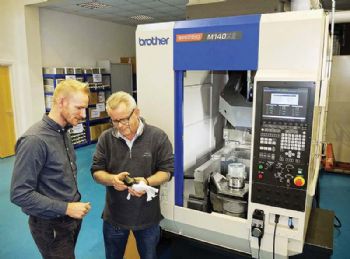
A Japanese-built Brother Speedio M140X2 five-axis mill-turn centre with a 22-position magazine for 30-taper tools has been supplied by Whitehouse Machine Tools Ltd (
www.wmtcnc.com) to a UK company that carries out world-leading R&D into the optimal design and manufacture of artificial knees and hips; it is also establishing a new manufacturing cell at its Centre for Manufacturing Research in Hallow — a village beside the River Severn, about two miles north-west of Worcester.
Terry Smith, managing director of Jointmedica, said: “The essence of successful implant performance is supreme quality, not only of the materials used but also of the design, manufacture and insertion of the prosthetic during orthopaedic surgery.
“A case in point is our Polymotion Hip Resurfacing concept — developed as a surgical alternative to total hip replacement.
“It comprises a highly polished femoral head that is currently produced by a partner company, using a special low-nickel cobalt-chrome alloy.
“This is attached to the top of the femur, which locates into a plastic acetabular cup inserted into the pelvis.”
Technical director Roger Ashton added: “Metal-on-metal hip resurfacing and hip replacement technology has all but disappeared globally, due to a number of products on the market performing below expectations — and in some cases causing significant problems in patients.
“That said, some designs with which I have been involved continue to perform extremely well, going on to deliver class-leading results in thousands of satisfied patients.
“Familiarity with this type of product provides the basis for our on-going development of hip resurfacings.”
He says that while the remaining hip re-surfacing solutions are metal-on-metal, a number of companies are exploring the use of ceramic-on-ceramic ‘articulations’ in an attempt to retain the advantages of this procedure compared with total hip replacement.
Indeed, Jointmedica is working with Derek McMinn and Ronan Treacy, who are both pioneers of hip resurfacing implant design and global authorities on metal-on-metal hip resurfacing from over 20 years’ experience with their previous enterprise — the Birmingham Hip Resurfacing division of Smith & Nephew Orthopaedics.
‘Cup final’
Together with these specialists, Jointmedica is undertaking research into the optimal grade of medical polymer to replace the cobalt-chrome previously used for the cup.
Indeed, it believes that this approach to hip resurfacing offers significant advantages to surgeons and — more importantly — the patients who may receive these implants.
The company ‘identified’ a type of highly cross-linked polyethylene with a porous coating as offering the ideal characteristics for use in hip re-surfacing.

Prototypes are undergoing exhaustive tests in the new R&D cell, which houses the Brother mill-turn centre — equipped with Blum in-process gauging and tool probing.
This machine allows simple turned forms and complex free-form implant shapes to be readily achieved.
Mr Ashton says that development products can be secured easily in an expanding collet on the torque table of the Brother M140X2, with turning and milling operations then combined to achieve the appropriate geometry, surface texture and finish.
Every completed implant is subsequently inspected on an Aberlink ‘Axiom too’ shopfloor co-ordinate measuring machine to confirm the geometrical characteristics and dimensional accuracy.
Function and wear simulators are used alongside the in-house development work to prove the safety and efficacy of the resulting implants.
In the case of hip resurfacing and hip replacement designs, these simulators load and articulate the bearing through millions of cycles in a manner that mimics human movement.
To support the venture financially, Jointmedica was awarded a Proof of Concept grant from Worcestershire County Council in October 2017 as part of the European Regional Development Fund.
Five months later, the company received further significant funding assistance from Innovate UK, whose remit is to find and drive science and technology that will expand the UK economy.
Mr Ashton said: “When we reviewed the options for the machining element of our manufacturing cell, which involves the complex milling of textured surfaces and the single-point turning of bearing surfaces, we originally thought we would need a five-axis machining centre and a CNC lathe.
“However, the Brother M140X2 mill-turn machine with its accurate turning capability via a direct-drive 2,000rev/min torque table can complete all the required cutting operations.”
Tool interface
Mr Ashton felt that a 30-taper tool interface would suffice for machining the range of materials to be used in these orthopaedic devices; there was also the advantage that such machines have a small footprint.
His preference was for a true five-axis machine rather than a three-axis model with a compound CNC table, as the former would ensure the necessary functionality within a compact envelope.

While three options were considered, the Brother machine was selected due to its superior turning capacity, as well as its fast axis movements.
These are carried out in four of the five CNC axes simultaneously during non-cutting times associated with the 0.9sec tool change, so idle times are minimal.
Cutting feed rates are up to 30m/min, maximising stock removal for high productivity.
Jointmedica manufacturing engineer Oliver Clayton said: “The capabilities of this machine are impressive. During my induction training, I was able to produce sample parts in record time.
“Indeed, the cutting performance and level of detail I can achieve with this variant of the Brother line-up exceeded our expectations.
“The package supplied by Whitehouse was comprehensive, consisting of not only the Brother machine and one week’s operator instruction at their Kenilworth technical centre, but also telephone support and recommendations regarding CAD/CAM software.
“We chose Alphacam, whose engineers have also been helpful. They defined the process, supplied the post-processor for the Brother mill-turn centre and provided training.
“With regard to machine control, the Brother high-speed C-00 system is not only user-friendly but also convenient for editing the off-line programmed feeds and speeds; and having a huge memory, it can hold multiple program files.”
In conclusion, Mr Smith said: “Once we have proved the Polyethylene Hip Resurfacing design and production process and obtained class 3 CE marking, we will be marketing a holistic design and manufacturing package to the big multi-national prosthetics producers.”